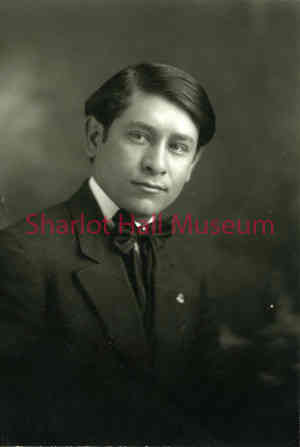Robert Turnbull
details
Unknown Unknown 1700-1545-0000.jpg PO-1545 B&W 1700-1545-0000 1700-1545-0000 Print 4x6 Historic Photographs 1900s Reproduction requires permission. Digital images property of SHM Library & ArchivesDescription
Robert Turnbull was born in Mexico in 1885. The names of his parents are unknown.
Robert married Jessie Burnett on April 16, 1908. They had one son, Robert B. Turnbull, born in Prescott, Arizona.
Robert became famous as a photographer and motion picture cameraman. He was the first cameraman hired by Warner Brothers studio during the silent films era. Robert was part of the Arizona Motion Picture Company. He ranked among the leading motion picture cameramen in the country.
Robert became the official photographer of the Mexican Constitutionalists (a faction during the Mexican revolution who fought against the dictatorship and aimed to restore a constitutional goverment in Mexico) where he made photos and movies of the troops to be shown in the U.S. to create public sentiment for their cause. U.S. Migration records show him travelling back and forth to Mexico numerous times.
Robert was involved in an Arizona court case involving his divorced wife in 1916. He claimed the divorce was granted while he was out of the country and unknown to him. It was further complicated by the fact that his wife had remarried. Robert wanted the divorce decree vacated. One of his arguments was that his wife did not live in Prescott for the year previous to her divorce, as per her statement.
Handwriting on photograph reads: "Robert A. Turnbull, Phoenix, Arizona".
No information found about Robert's death.
Sources: Arizona, Marriages, 1865-1949; Arizona, Maricopa County, Voting Records, 1876-1932; Casa Grande Dispatch 5-9-1914; Tucson Citizen 10-14-1913, 4-9-1914; Weekly journal-miner 2-9-1916; Arizona Memory Project 8-21-1913; U.S. Migration Records 1905-1952.
Purchase
To purchase this image please click on the NOTIFY US button and we will contact you with details
The process for online purchase of usage rights to this digital image is under development. To order this image, CLICK HERE to send an email request for details. Refer to the ‘Usage Terms & Conditions’ page for specific information. A signed “Permission for Use” contract must be completed and returned. Written permission from Sharlot Hall Museum is required to publish, display, or reproduce in any form whatsoever, including all types of electronic media including, but not limited to online sources, websites, Facebook Twitter, or eBooks. Digital files of images, text, sound or audio/visual recordings, or moving images remain the property of Sharlot Hall Museum, and may not be copied, modified, redistributed, resold nor deposited with another institution. Sharlot Hall Museum reserves the right to refuse reproduction of any of its materials, and to impose such conditions as it may deem appropriate. For certain scenarios, the price for personal usage of the digital content is minimal; CLICK HERE to download the specific form for personal usage. For additional information, contact the Museum Library & Archives at 928-445-3122 ext. 14 or email: orderdesk@sharlot.org.




